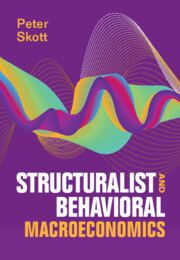Book contents
- Frontmatter
- Contents
- Figures
- Preface and Acknowledgments
- 1 Introduction: The State of Macroeconomics
- 2 The Lucas Critique and Representative Agents
- 3 Household Consumption and Saving
- 4 Saving in a Corporate Economy
- 5 Phillips Curves and the Natural Rate of Unemployment
- 6 Fairness, Money Illusion, and Path Dependency
- 7 Earnings Inequality, Power Bias, and Mismatch
- 8 Macroeconomic Adjustment and Keynes’s Instability Argument
- 9 Growth and Cycles
- 10 Endogenous Growth Cycles with or without Price Flexibility
- 11 Secular Stagnation and Functional Finance
- 12 Concluding Comments: Evidence-Based Macroeconomics and Economic Theory
- References
- Author Index
- Subject Index
7 - Earnings Inequality, Power Bias, and Mismatch
Published online by Cambridge University Press: 10 November 2023
- Frontmatter
- Contents
- Figures
- Preface and Acknowledgments
- 1 Introduction: The State of Macroeconomics
- 2 The Lucas Critique and Representative Agents
- 3 Household Consumption and Saving
- 4 Saving in a Corporate Economy
- 5 Phillips Curves and the Natural Rate of Unemployment
- 6 Fairness, Money Illusion, and Path Dependency
- 7 Earnings Inequality, Power Bias, and Mismatch
- 8 Macroeconomic Adjustment and Keynes’s Instability Argument
- 9 Growth and Cycles
- 10 Endogenous Growth Cycles with or without Price Flexibility
- 11 Secular Stagnation and Functional Finance
- 12 Concluding Comments: Evidence-Based Macroeconomics and Economic Theory
- References
- Author Index
- Subject Index
Summary
New information technology has allowed firms to monitor many low-paid workers more closely, putting downward pressure on their wages and increasing work intensity. At the top end of the income distribution, meanwhile, the new technologies have increased firm-level volatility, thereby weakening the ability of owners to monitor managerial performance, increasing the power of top managers, and contributing to an explosion in executive pay. Technological power biases have been reinforced by institutional changes, including declining rates of unionization, falling minimum wages, and changes in intellectual property rights, business regulation and anti-trust policies. The sources of inequality matter. Education will be a primary instrument if skill biases are the main source. But many workers hold jobs for which they are overeducated. This mismatch between workers’ skills and the skill requirements of the jobs can emerge naturally in an efficiency-wage model. In this setting, relative wages are insensitive to changes in the relative supply of high-skill workers; an increase in the minimum wage, by contrast, can raise employment and reduce inequality.
Keywords
- Type
- Chapter
- Information
- Structuralist and Behavioral Macroeconomics , pp. 173 - 202Publisher: Cambridge University PressPrint publication year: 2023



